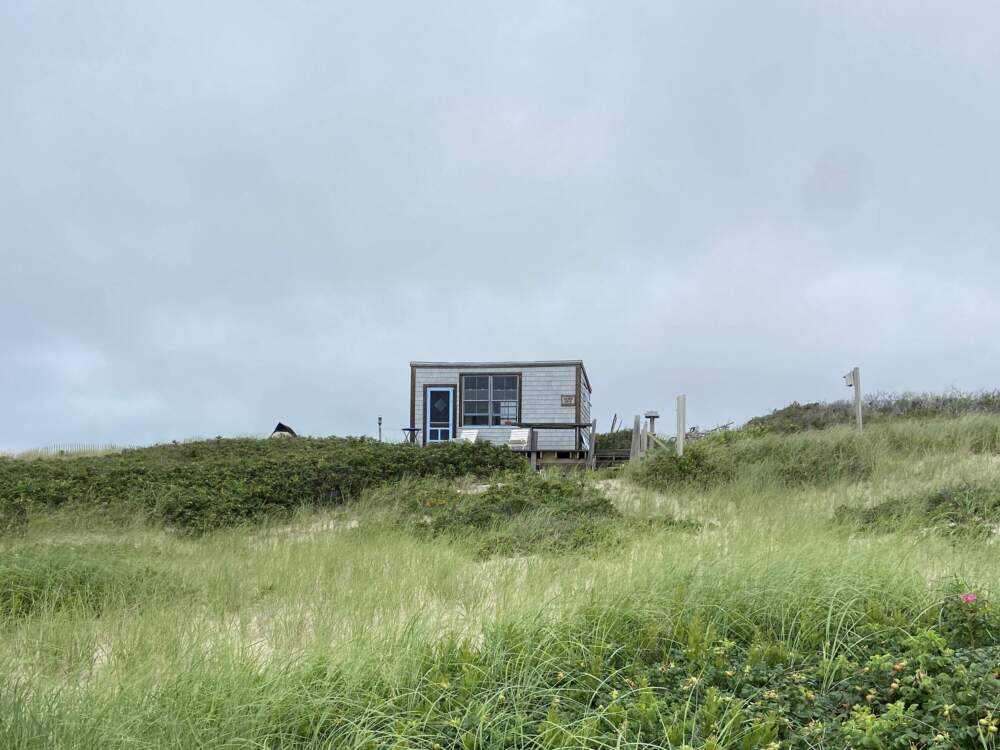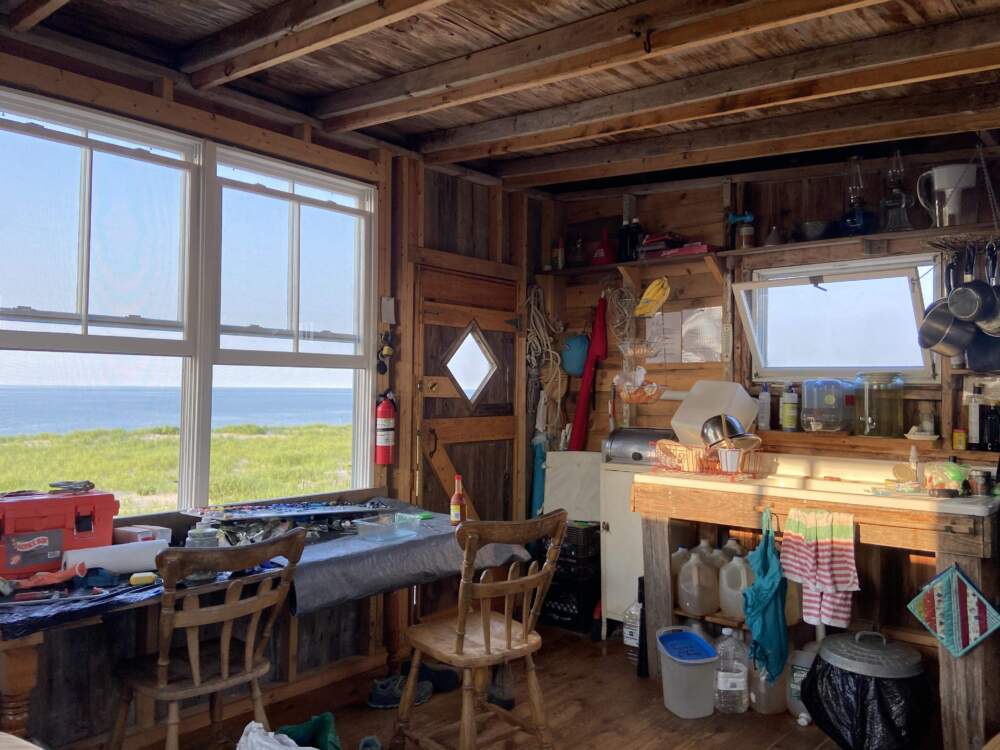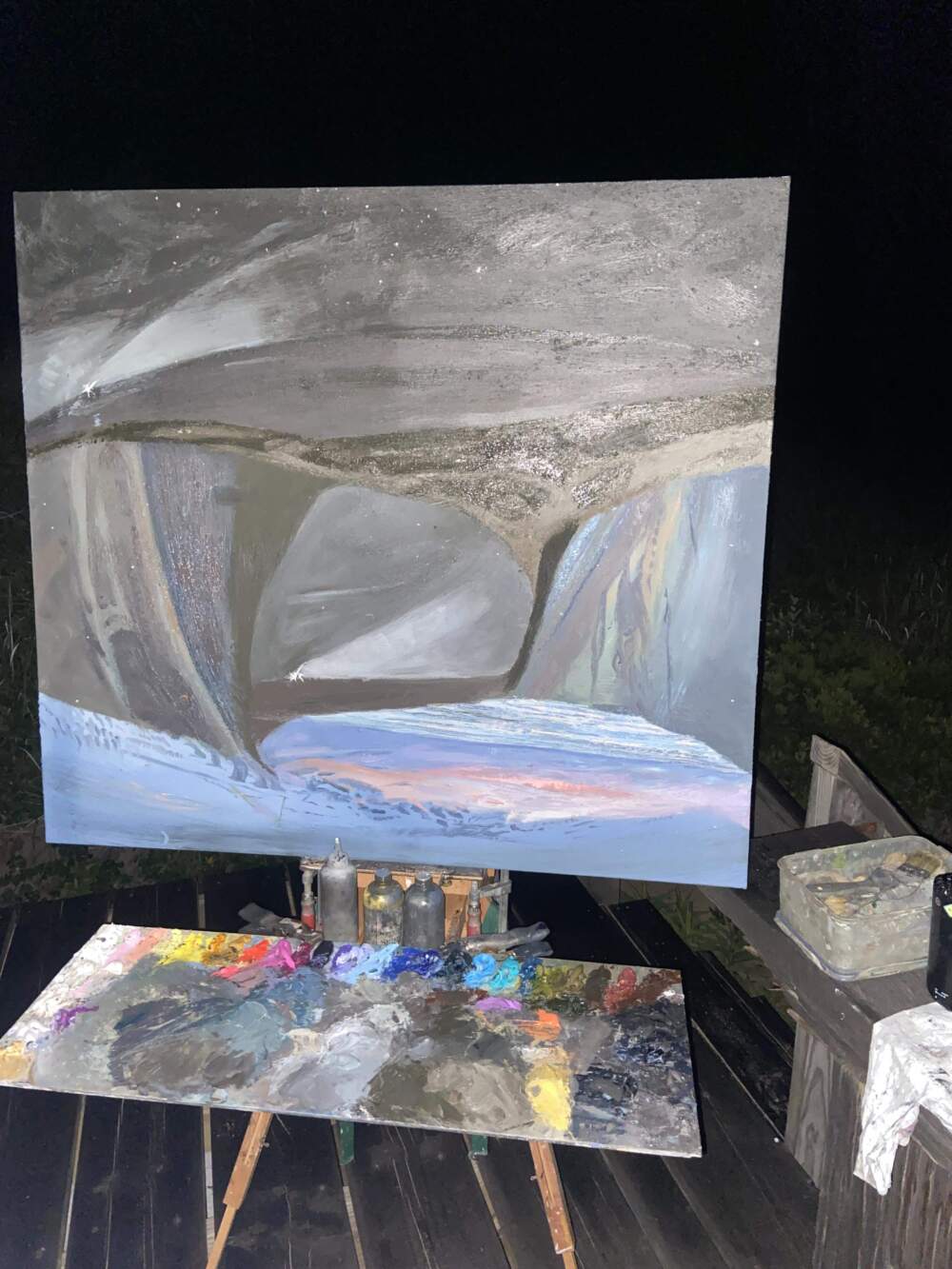Advertisement
Commentary
Painting Cape Cod's dunes in the dark, I trusted it would all add up in the morning

For two weeks in July 2023, I lived off the grid in a dune shack on the Cape Cod National Seashore for an artist residency supported by the Peaked Hill Trust and The Fine Arts Work Center. I planned to make paintings of the surrounding dunes and ocean on a nocturnal schedule. I’d begin at sunset each night, and work until dawn.
By day, my painting practice is a watchful one. I look out and see things coming from far away. But by night, when the visual world breaks down, all my senses are on high alert, and I paint my way through disorienting territory. Night painting challenges the capacity of my body to adapt, creating a kind of trust exercise between the land, my senses and the work. The absence of visual information makes space for a deeply emotional and physical encounter. That’s the liminal space I hoped to sink into while night painting in the dunes.
Many logistics led up to this trip — building canvases, packing paint and brushes, constructing boxes that could transport wet paintings at the end of the residency, packing enough nonperishable food and supplies to live without electricity and indoor plumbing for 14 days, and letting people know I’d be unreachable since cell service is spotty in the dunes. My accommodations were simple and sustainable. I pumped my water from a well and cooked on a propane camp stove. There were solar lights and a solar-powered fridge. A guide named Noah drove me and my gear to the shack on a labyrinthian sand road in a Toyota pickup. When we arrived, he showed me an airhorn labeled “FIRE.” If the historic structure were to ignite on my watch, I was supposed to sound the horn three times so my neighbors could bring buckets of water to fight the fire. They all had horns, too. I felt a sense of solidarity knowing I was distantly surrounded by other working artists and shack dwellers just a horn blast away.

My shack’s name was Margo-Gelb, after the artists Boris Margo and Jan Gelb, who were its longtime inhabitants in the mid-to-late-20th century. It is perched high above the ocean on a steep sand hill, precariously exposed to the elements and shielded by the surrounding dunes and shrubs. The front of the shack, with two tall windows and a sun-bleached cobalt blue door, faces north — keeping watch over the Atlantic Ocean and Race Point Beach below. A tangle of rosehips, dune grasses, snow fencing and driftwood borders the shack and the dune it sits on, providing protection from the winter gales and giving the transitory sand something to hold onto.
The first night I painted in the dunes, I could hardly see anything. A wet fog hung dark and thick, fading from blue-gray twilight to pitch black. From the high perch of the shack porch, I couldn’t see the horizon, or the stars, the glow of the Pilgrim Monument, the aeronautical beacon of Provincetown Airport just across the dunes or Highland Lighthouse five miles to my southeast. In the dark, I grasped for ways to orient myself.
I could imagine these dunes witnessing shipwrecks on nights like this, when lamplight warnings on shore would be indiscernible through the fog. The shack is built on a site near where the original Peaked Hill Life Saving Station once stood. Here, the U.S. Coast Guard looked out over this dangerous stretch of ocean, warning ships and deploying rescue efforts when mariners wrecked on sandbars. In 1931, when writer Eugene O’Neill owned the old Station, which he used as a writing retreat, a storm pulled the shack over the edge of the dunes, like an offering to the sea. Margo and Gelb built a new structure there in the 1940s, and ever since, countless artists and writers have stayed in this shelter and kept watch. I think of my painting practice as an act of keeping watch, too. I anticipate things coming, so it felt fitting to take this nightshift, where many had looked out before me.

I thought of Jan Gelb who stayed in this same shack for many summers, and what she might have seen and felt. While writing this, I came across an etching she made, titled “Channels of Night” (1957). In this image, curved geometric shapes spiral around the composition. White triangles cut through dark corrosive grays like sails. Having studied this arrangement of shapes, I’m convinced we both witnessed the dunes in similar conditions— the carving movement of the wind, triangular beams of light from a passing boat or the moon.
At sunset, I would secure my canvas to a folding easel, and load my long plexiglass palette with piles of inky oil paint. There was no electricity in the dune shack, so once night fell, I used a lantern to see. I tied a headlamp around my wrist, and used it to illuminate my painting and palette. I couldn’t wear it on my head because the bugs, attracted to the light, would dive bomb at my face. Painting became a slow process of adjusting and reacting. I would turn off my lamp, wade through the disorienting darkness with my eyes and ears, searching for any form, shape or movement I could grasp. I would think about how to mix the colors I was seeing, then turn my lamp back on, mix those colors and paint them on the canvas. And when the moths and mosquitos found my light, I’d go dark again, repeating this cycle of adjusting and trusting until the earth rotated into sunlight. Sunrise illuminated each night’s vigilant guesswork, and signaled the hour to rest until the next nightwatch.
Advertisement
The moon was approaching a new moon, and rose increasingly close to dawn for the first several nights. I was only able to see and paint the moon on three nights when she rose before dawn as a hot red fingernail over the horizon before vanishing into daylight for the next week and a half. On dark moonless nights, familiar constellations, lightning and an occasional shooting star all became beacons I could orient myself to. Several nights in a row, I saw and heard the same clam dragger emerge around the northern curve of Race Point. I wondered if they could see my pathetic headlamp in the dunes, too.

Painting in the landscape is a conduit through which I learn, express and commune. I’m looking for and sending out signals, processing emotions through my physical encounters with a place. Under the stars, I felt both unsettled and lost in the dark, disoriented by my own senses, placing all my trust in the place around me and the paintings themselves. Even on the darkest, foggiest nights, twilight would cycle through to daylight, literal clockwork. I could trust that it was coming.
But I also had to trust my senses, my hands, my marks. Trust my materials. Trust that this place was looking out for me, and I for it. Trust the guidance of all the artists before me. Trust that it would all add up in the morning.
Elizabeth Flood is a featured artist in Edge Condition, a summer exhibition at the Hudson D. Walker Gallery in Provincetown, Mass.
